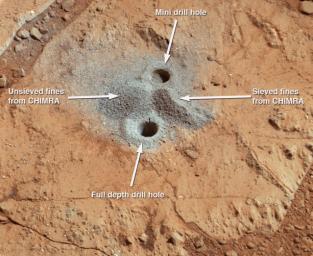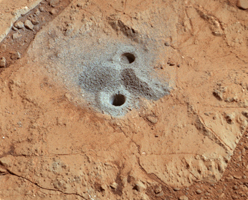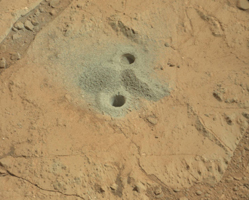
|
Dust from Mars Drilling: Tailings and Discard Piles
- Click the image above for a larger view
- Full-Res JPEG (1420 x 1159) (335.9 kB)
- Full-Res TIFF (1420 x 1159) (4.9 MB)
Caption:
|
Click on an individual image for larger views
This image shows the first holes into rock drilled by NASA’s Mars rover Curiosity, with drill tailings around the holes plus piles of powdered rock collected from the deeper hole and later discarded after other portions of the sample had been delivered to analytical instruments inside the rover. The image was taken by the telephoto-lens camera of the rover’s Mast Camera (Mastcam) instrument in early afternoon of the 229th Martian day, or sol, of Curiosity’s work on Mars (March 29, 2013). The site is on a patch of flat rock called “John Klein” in the “Yellowknife Bay” area of Mars’ Gale Crater.
Each of the drill holes is about 0.6 inch (1.6 centimeters) in diameter. The one toward the top of the image was drilled on Sol 180 (Feb. 6, 2013) as a "mini drill" preparatory test. That test went to a depth of 0.8 inch (2 centimeters) without collecting any rock powder. The nearer hole is from the first rock-drilling ever to collect a sample on Mars. Curiosity drilled this hole 2.5 inches (6.4 centimeters) deep on Sol 182 (Feb. 8, 2013).
Analysis of the collected John Klein rock sample by the Chemistry and Mineralogy (CheMin) and Sample Analysis at Mars (SAM) instruments inside Curiosity produced evidence of an ancient wet environment that provided favorable conditions for microbial life, including elemental ingredients for life plus a chemical energy gradient such as some terrestrial microbes exploit as an energy source.
The sample processing and delivery tool on Curiosity, called the Collection and Handling for In-situ Martian Rock Analysis, or CHIMRA, put the collected powder through a sieve to screen out particles larger than 0.006 inch (150 microns) across, and then delivered portions of the sieved material to the instruments. After delivering a few portions for analysis over the course of several weeks, CHIMRA released both the material that had not passed through the sieve and the leftover sieved material, dropping them in two piles near the drill hole on Sol 229 (March 29, 2013). In this image from a few minutes later, the unsieved material forms a mound to the left of a line between the two holes and the leftover sieved sample material forms a mound to the right.
The image has been white-balanced to show what the rock material would look like if it were on Earth. Two unannotated versions, white-balanced and raw color (showing what the rock material looks like on Mars to the camera) are available as Figure 1 and Figure 2.
Background Info:
Malin Space Science Systems, San Diego, developed, built and operates Mastcam. NASA's Jet Propulsion Laboratory, Pasadena, Calif., manages the Mars Science Laboratory Project and the mission's Curiosity rover for NASA's Science Mission Directorate in Washington. The rover was designed and built at JPL, a division of the California Institute of Technology in Pasadena.
More information about Curiosity is online at http://www.nasa.gov/msl and http://mars.jpl.nasa.gov/msl/ .
Cataloging Keywords:
| Name | Value | Additional Values |
|---|---|---|
| Target | Mars | |
| System | ||
| Target Type | Planet | |
| Mission | Mars Science Laboratory (MSL) | |
| Instrument Host | Curiosity Rover | |
| Host Type | Rover | |
| Instrument | Mast Camera (MastCam) | |
| Detector | ||
| Extra Keywords | Color, Crater, Dust | |
| Acquisition Date | ||
| Release Date | 2013-04-08 | |
| Date in Caption | 2013-02-06 | 2013-02-08, 2013-03-29 |
| Image Credit | NASA/JPL-Caltech/MSSS | |
| Source | photojournal.jpl.nasa.gov/catalog/PIA16815 | |
| Identifier | PIA16815 | |


